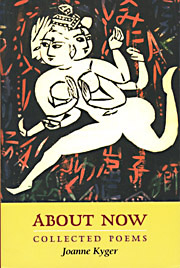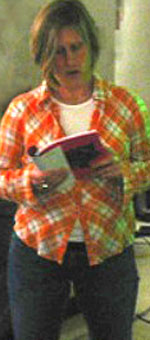

This piece is about 4 printed pages long.
It is copyright © Linda Russo and Jacket magazine 2007.
This is Linda Russo’s Introduction to Joanne Kyger’s About Now — Collected Poems, which is available from Small Press Distribution.
paragraph 1
How to introduce a body of work shaped by change? To encapsulate the many ways in which Joanne Kyger’s poetry, for fifty years, has met this challenge: to “keep that vivid vivid experience / alive” (544)? Kyger evinces a lifelong commitment to poetry as a mode of presence in and awareness of the phenomenal world, and she does so in her own way–“camouflaged / with simplicity.” Robert Creeley has called her “whimsically tough minded”; sometimes prodding, ceaselessly engaging, she reconfigures received categories of understanding (poem, journal) to accommodate observation, dream, gossip, question, and fact in a style that is utterly sharp and inimitable:
2
Who even said I was a poet. Because I write
this down. I want bullet-like speed and precision
to show that this mind connects in ways of delight, and
also says truth way beyond this individual voice (279)
3
Her every poem is a daily thought companion, attending with humor and humility to the “serious business / [of] this existence thing / this life” (626).
4
Born in Vallejo, California, in 1934, Kyger attended the University of California, Santa Barbara, departing one credit short of her bachelor’s degree. She arrived in San Francisco in 1957 amid the aftershocks of the Howl censorship trial. There, along with a few other young poets, some from the recently dissolved Black Mountain College, she absorbed the informal teaching of Robert Duncan and Jack Spicer, who presided over a series of “Sunday Meetings”; this became her first poetic school. She was, by all accounts, a beauty: long-limbed and graceful in her black dress and black Capezios, de rigueur bohemian garb. She met Philip Whalen in 1959 at the East-West House, a Zen center in San Francisco where she lived and studied while preparing to travel to Japan to join Gary Snyder (her husband from 1960-64). In Japan, Kyger continued her studies on her own; Snyder’s school did not admit female students. She later joined him on a trip to India with Allen Ginsberg and Gregory Corso. Jonathan Skinner has appropriately dubbed the journals she kept during this period a sort of captivity narrative. In those writings (now republished as Strange Big Moon: The Japan and India Journals), she ponders her poetics and keeps a daily account of the goings on around her, expressing frustrations with both married life and her attempt at a disciplined study of Buddhism. Here too she plants the kernel of many of the poems that would appear in her first book, The Tapestry and The Web (1965). A re-articulation of The Odyssey in which the figures and narratives of Odysseus and, more significantly, Penelope are revised and modernized, Tapestry situates Kyger in the Pound tradition even as it shows her struggling to overthrow that tradition’s preconceptions regarding women.
5
Bringing Eastern and Western influences together, Kyger, like many of her generation, was a transpacific Walt Whitman. And she incorporated the lessons of Charles Olson’s “Projective Verse” to articulate mind, breath, and line in a manner distinct from Ginsberg’s improvisational “first thought best thought” or Whalen’s inward “graph of a mind moving.” Her vivid and carefully crafted poems posit connections between self and world: “Perfect thought / the relationship of everything / to everything” (as she writes in “Joanne” [199]). For Kyger, this “everything” includes not only her immediate environment, but also a substratum of history, memory, and myth, a familiar “underworld ... furnished with raw understanding” (685).
6
In 1969, Kyger moved to the small coastal town of Bolinas, California (where she still resides) to “drop out” and make “a place to live / ... in the greened out 70s” (378). Many poets gathered in or passed through the area–Ted Berrigan, Tom Clark, Robert Creeley, Anne Waldman, and Lewis Warsh among them–and several small presses came into existence there under the spell of a mimeo- and Dexedrine-induced poetics of rapid production. Her poems of the 1970s revel in the liveliness of the Second Generation New York School poets–a group of fast thinkers, list-makers, dream-recorders, and cut-up artists for whom writing and publishing was a form of community-making. In this period of fantastic stories and surprising revelations, Kyger charts outward journeys and inward turns of mind. A boisterous road trip “to the East in a drive away car” is recorded in “Trip Out & Fall Back” and group exploits on a Puerto Rico vacation comprise “Desecheo Notebook.” Yet amid the daily accounts of social activity in these travel poems–attending a loft party, keeping track of a dwindling supply of cigarettes, searching for the apparently stolen head of a native sculpture–Kyger continues to work out her phenomenological poetics: “Writing. I am a writer and a talker. I get hungry too” (239).
7
This narrative inclusiveness held sway in her poems through the early 1970s (“And I know this is my focus to meander” [361]), but Kyger’s later work trims the exposition, is the writing of a poet who “loves to fuss / and prune with the mythology / of under and overtones” (688). With stunning precision she weaves the here and now into a lush surface of observed detail: animals, plants, water, people, moon and sky are threaded with “positing thoughts in this or that direction” (688). Kyger is ever conscious of when she lapses into a pattern of thought, even a beautiful one, say “[a] strand / of conscious thinking vibrating like a watery / jewel on the morning’s cobweb” — a line she immediately recognizes as an “attempt to cliché the moment”(625). Thus attention remains fresh despite the “repetitious feel” of “one’s history / in one place” (530). Appended with dates and often untitled, her seemingly simple journal-entry poems belie the complexity of a perfected method: mind pushed to the edge of certainty, poem sketched in a moment of mindful not-knowing — a fine-tuning of attention and language that results in statements both captivating and sprightly, in arrangements on the page both spacious and graceful.
8
As important as Bolinas and the here and now are to Kyger’s poetics, her frequent travels to Mexico and her delving into myths and histories are purposeful removes no less central to her writing. Poems like “The News from Pátzcuaro” and “Up Here with the Clouds,” from a daybook written during a five-week stay in a Mexican colonial village built atop the ancient dwellings of the Purepecha people, are examples of her “portable poetics,” as Andrew Schelling calls it. “Up My Coast” retells the myths of the “First People” of the Bolinas coastal region; “Some Sketches from the Life of Helena Petrovna Blavatsky” presents the nineteenth-century world-traveler and spiritualist who introduced Buddhism to the west. In all these works, Kyger’s “mind find[s] / teachings in many realms,” amplifying her understanding of the here and now with cross-cultural and transhistorical awareness (672). “Death Valley Desert Notes” sets forth her methodology: “to chronicle / events economically” and learn, from sitting and observing a place, to “respect / and awe majestic old time news” (508).
9
Kyger’s more recent poems place her among our most diligent of ecological poets. Attentive to the geography of her Pacific coast home with its “cast of characters . . ./ going through a season” (570), her poems track her (and our) interdependence “in the gather dome” (584). A multi-sensual realism characterizes her encounter with nature: she makes note of “the briars that scratch / the wrist” (471), of a “turquoise blue balloon caught in the pine” (489), of an “unfamiliar warble” that sends her running for binoculars (688). Reading Kyger, we become familiar with the porousness of life atop the Bolinas mesa, where her small writing outpost with its large sliding glass door sits at a distance from her modest abode surrounded by shrubs, flowers, garden, and woods with their resident and itinerant creatures; where a short walk away the road opens up to Pacific Ocean vista; where thought abides by the rhythms of moon and season. She reminds us that we depend on nature to be what it is, separate yet entwined; and that it is our responsibility to practice respectful awareness–whether this takes the form of knowing a bird by the sound of its song or protecting native plant species. Her poems, in bearing witness to all this, ask us to recognize and honor our surrounding ecologies, and provide a practical lesson in how to do that.
10
Whalen dreamed of an America dotted with secret locations–places like Kyger’s Thoreauvean writing shed–where people could hide out, practice meditation, and work. “This is something that I think is necessary in order for human beings to go on being human beings,” he wrote. For Kyger, “being a human being” is manifested in an awareness of what surrounds the self. We are immediately invited into these poems by her wit and piquant observation; we are drawn in by a subtle yet very real invitation to be with her in the moment. Their marvelous swiftness, accuracy and unpredictability is an experience for which we are that much richer:
11
Not too much happens strands
of consciousness strands of dreams
precious, rare and mundane, where we live (530)
12
Kyger returns us to “where we live.”

Linda Russo
Linda Russo is the author of MIRTH (Chax 2007). She has a contributed an essay, ‘Writing Within: Notes on Ecopoetics and Spatial Practice’, to a feature on women and ecopoetic forthcoming in How2, and poems are forthcoming in EOUGH, Kiosk, ecopoetics and elsewhere. She curently lives in Norman, Oklahoma.
The Internet address of this page is http://jacketmagazine.com/34/kyger-russo-intro.shtml